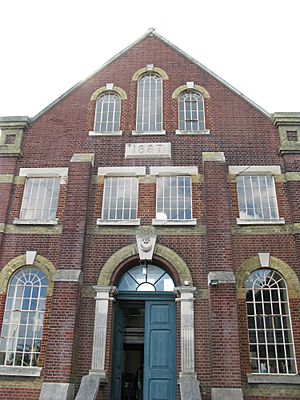Eastney Beam Engine House facts for kids
The Eastney Beam Engine House is a special old building in Portsmouth, Hampshire, England. It was built during the Victorian era in 1887. This means it's over 130 years old! It's also a "Grade II-listed" building, which means it's important and protected because of its history and design.
Inside, you'll find two huge machines called beam engines. These engines were very powerful, each having 150 horsepower. They were made by a famous company called James Watt & Co.
What Was Its Job?
The Eastney Beam Engine House was built for a very important reason: to help clean up Portsmouth. Back then, the city needed a better way to deal with its sewage, which is wastewater from homes and businesses.
The engines were part of a big plan. They worked with large holding tanks. These tanks would collect the sewage. Then, when the ocean tide was going out (called the ebb tide), the powerful beam engines would pump the sewage far out into the sea. This helped keep the city clean and healthy.
From Workhorse to Museum
Over time, new and more modern technology came along. The old beam engines were no longer needed for their original job. However, people realized how special these machines were.
In 1980, the engines and the building were carefully restored. This means they were fixed up to look and work like new again. Different groups helped pay for this, including Portsmouth City Council, Hampshire County Council, and the Department of the Environment. They gave money to make sure these important machines could be saved.
Today, the Eastney Beam Engine House is open to the public as a museum. It's owned by Portsmouth City Council. Volunteers, who are people who help for free, run the museum. Because volunteers run it, the museum is usually open on the last weekend of every month. It's a great place to see how people used amazing machines to solve big problems in the past!
Find Out More
- Portsmouth City Museums: Eastney Beam Engine House
- Eastney Beam Engine House (at Portsmouth Guide)
- Photos of the inside of the Engine House



